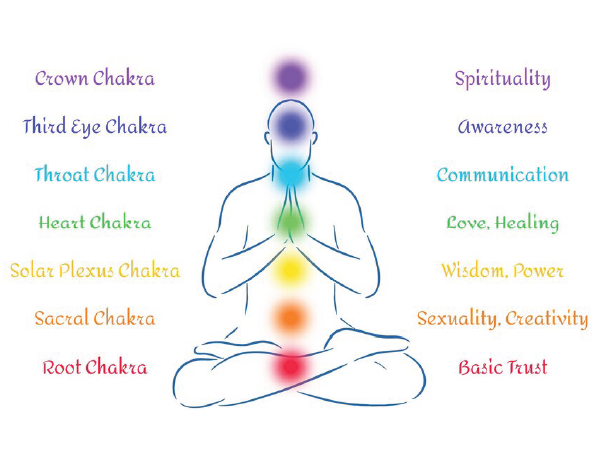All living things have energy flowing through them. As humans, we have a field of energy that surrounds our bodies as far as our outstretched arms and from head to toe. Since we have many different kinds of energy like creative energy, thought energy, and love energy, our bodies need special centers to manage and organize these energies. These centers receive the energy, translate it, and express it in different ways.
For example, when you eat an apple, your body turns the food into energy. The energy centers then use that energy to help you move, think, or feel.
These energy centers are called chakras. Chakras are like spinning wheels of energy that help organize and manage our body’s functions. The word “chakra’ actually means “wheel” and each chakra corresponds to major organs and nerve bundles. Chakras aren’t physical objects like organs; instead, they’re more like emotions or ideas–you can’t see or touch them, but they’re still there.
Just like our emotions can affect our health, so can the state of our chakras. They influence our cells, organs, and hormone systems, and can affect our thoughts and behaviors. To work properly, chakras need to stay open and balanced. If they become blocked and imbalanced, you might experience physical or emotional issues related to that particular chakra. Keeping your chakras balanced helps you feel and function at your best.
There are seven main chakras along your spine, from the base of your spine to the top of your head. There are also smaller chakras in places like your hands and feet. The lower chakras deal with basic needs like survival and movement, while the higher chakras are about more conceptual things like communication and consciousness.
Each main chakra has a specific purpose:

The development of each chakra and the skills related to it happen throughout our lives. From birth to adulthood, we go through the first cycle of chakra development. Once we reach adulthood, this cycle starts again but on a more complex level, and it keeps repeating throughout our lives.
Each chakra’s healthy development helps the next chakra develop properly. Since all the chakras are connected and work together, problems or traumas during one chakra’s growth can affect the higher chakras.
For example, if you experience issues during the development of the first chakra, which is about survival and stability, it might make it harder for you to feel secure. This insecurity can then affect the second chakra, which deals with creativity and emotions, and so on. Keeping all chakras balanced and healthy is important for overall well-being.
When we face stress, trauma, or tough experiences, we often develop ways to handle them for survival. These coping strategies usually fall into two types: either focusing a lot of energy to confront the problem or reducing energy to avoid dealing with it. This can lead to either too much or too little coping.
When a chakra becomes excessive, it means too much energy stays in the body, making it overactive and stagnant. On the other hand, a deficient chakra means too much energy leaves the body, making it passive and unresponsive. Sometimes, we might experience both excessive and deficient coping in the same chakra at different times.
A healthy, balanced chakra has energy flowing in and out equally. This balance helps us cope with challenges effectively without becoming overwhelmed or avoiding them altogether. Understanding and maintaining this balance is crucial for our overall well-being.
Imagine someone who has been hurt many times in close relationships. Now, they avoid getting close to others or showing love because they fear getting hurt again. This is an example of an imbalanced chakra, where there is too much energy going towards withdrawal and not enough towards healthy connection and openness.
If you often deal with chronic illness or pain, focusing on your chakras can help with your healing process. Looking at your health through a chakra perspective means considering your whole system–your past experiences, stress, and traumas–to understand the real cause of the issue, not just the symptoms. Healing isn’t just about taking medicine; it’s about making a dedicated effort with sensitivity and attention to detail.
For example, if you have frequent headaches, taking painkillers may mask the problem but will not get to the core of the issue. You could instead explore if there’s an imbalance in your communication chakra (throat chakra), which could be causing tension and stress. By addressing the root cause through chakra healing practices like meditation or energy work, you might find longer-lasting relief and overall better health.
Terms of Use Accessibility Statement Privacy Policy Cookies/US
© 2024 CLEANSING VIBES WELLNESS COLLECTIVE, ALL RIGHTS RESERVED
To provide the best experiences, we use technologies like cookies to store and/or access device information. Consenting to these technologies will allow us to process data such as browsing behavior or unique IDs on this site. Not consenting or withdrawing consent, may adversely affect certain features and functions.